Philips HeartStart OnSite Defibrillator M5066A User Manual
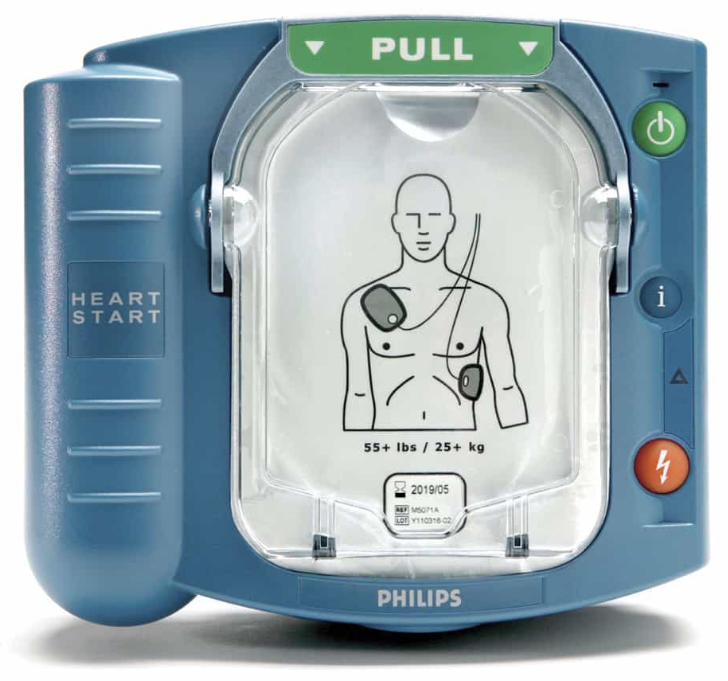
Content
Introduction
The Philips HeartStart OnSite Defibrillator M5066A is a user-friendly automated external defibrillator (AED) designed for those with little or no medical training. This device provides clear, step-by-step voice instructions to guide users through the process of delivering a lifesaving shock in cases of sudden cardiac arrest. Compact and portable, it conducts regular self-tests to ensure readiness. Priced at approximately $1,628.00, it is an essential tool for emergency preparedness in homes and public spaces.
Product Overview
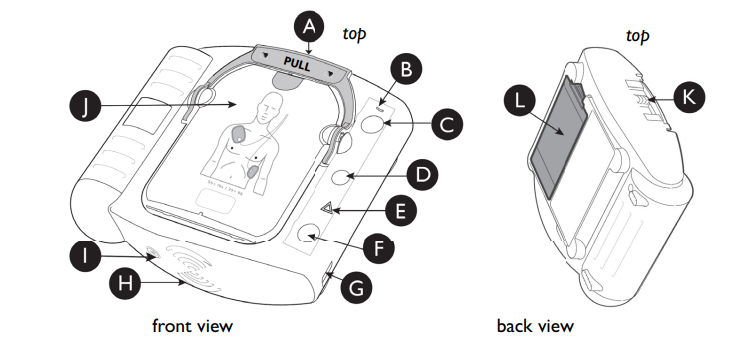
- Pads Cartridge Handle
Pull the handle to turn on the OnSite and remove the cartridge’s hardcover. - Ready Light
This green light tells you the readiness of the OnSite.- Blinking: standby mode (ready for use)
- Solid: in use
- Off: needs attention (OnSite “chirps” and i-button flashes)
- On/Off Button
Press this green button to turn on the OnSite. To turn off the OnSite, press the green button again and hold it down for one (1) second. - Information Button
This “i-button” flashes blue when it has information you can access by pressing it. It also flashes at the beginning of a patient care pause when CPR guidance is enabled. - Caution Light
This triangular light flashes during rhythm analysis and is on when a shock is advised, as a reminder that no one should be touching the patient. - Shock Button
When instructed by the OnSite to deliver a shock, press this flashing orange button . - Infrared (IR) Communications Port
This special lens, or “eye,” is used to transfer OnSite data directly to or from a computer. - Speaker
When the device is being used, its voice instructions come from this speaker. - Beeper
The OnSite “chirps” through this beeper to alert you when it needs attention. - SMART Pads Cartridge
This disposable cartridge contains self-adhesiv pads with attached cable. Shown with adult OnSite pads cartridge. - SMART Pads Cartridge Latch
Slide the latch to the right to release the pads cartridge for replacement. - Battery
The nonrechargeable battery is inserted in a recess on the back of the OnSite.
TECHNICAL INFORMATION
HEARTSTART ONSITE DEFIBRILLATOR SPECIFICATIONS
The specifications provided in the following tables are nominal values.
PHYSICAL
category | specifications |
size weight | 2.85 in H x 7.40 in D x 8.30 in W (7.2cmH x 19cm D x 21cm W). Approximately 3.3 pounds (1.5 kg) with battery and pads cartridge installed. |
ENVIRONMENTAL
category | specifications |
temperature and relative humidity | Operating (battery and pads cartridge installed): 32° to 122° F (0° to 50° C); 0% to 95%RH (non-condensing). Standby (between uses with battery and pads cartridge installed): 50° to 109° F (10° to 43° C); 10% to 75% RH (non-condensing). Storage/shipping (with battery and pads cartridge): -4° to 140°F (-20° to 60° C) for up to 2 days; 0% to 85%RH (non-condensing). |
altitude | Operates at 0 to 15,000 feet (4,572 m); can be stored at up to 8,500 feet (2,591 m), in standby mode. |
atmospheric pressure | Operates at 1013 hPa to 590 hPa; can be stored at up to 750 hPa, in standby mode. |
shock/drop abuse tolerance | Withstands 3.3 foot (1 meter) dropto any edge,corner, or surface. |
vibration | Operating: meets EN1789 random, road ambulance. Standby: meets EN1789 swept sine, road ambulance. |
sealing
ESD/EMI (radiated and immunity) | Meets IEC 60529 class IP21. Protected against access to hazardous parts with a finger and protected against ingress of solid foreign objects of 0.5 in (1.25 cm) diameter and greater per IEC 60529 classIP2x. Protected against a uniform flow of water drops over the defibrillator per IEC 60529 class IPxI. See Electromagnetic Conformity tables. |
CONTROLS AND INDICATORS
category | specifications |
controls | Green SMART Pads Cartridge handle Green On/Off button i-button (flashes blue) Orange Shock button |
indicators | Ready light: green;blinks when the OnSite is in standby mode (ready for use); solid when the OnSite is being used. i-button: flashes blue when information is available, on solid during patient care pause. Caution light: flashes when the OnSite is analyzing, comes on solid when the OnSite is ready to deliver a shock. Shock button: orange, flashes when the OnSite is charged and ready to deliver a shock. |
audio speaker | Provides voice prompts and warning tones during normal use. |
beeper | Provides chirps when troubleshooting is needed. |
DEFIBRILLATION WAVEFORM
category | specifications |
waveform parameters | Biphasictruncated exponential.Waveform parameters are automatically adjusted as a function of patient defibrillation impedance. In the diagram at left, D is the duration of phase 1 and E is theduration of phase2 of the waveform, F is the interphase delay (500 μs), and Ip is the peak current. The OnSite delivers shocks to loadimpedances from 25 to 180ohms.The duration of each phase of the waveform is dynamically adjusted based on delivered charge, in order to compensate for patient impedance variations,as shown below: adult defibrillation load phase 1 phase 2 peak delivered resistance(Ω) duration (ms) duration (ms) current (A) energy (J) 25 2.8 2.8 55 128 50 4.5 4.5 32 150 75 6.3 5.0 23 155 100 8.0 5.3 18 157 125 9.7 6.4 14 159 150 11.5 7.7 12 160 175 12.0 8.0 11 158 pediatric defibrillation (using M5072A infant/child SMART defibrillator pads) load phase 1 phase 2 peak delivered resistance(Ω duration (ms) duration (ms) current (A) energy (J) 25 4.1 2.8 24 35 50 5.1 3.4 16 46 75 6.2 4.1 12 52 100 7.2 4.8 10 54 125 8.3 5.5 8 56 150 9.0 6.0 7 57 175 9.0 6.0 6 55 |
energy* (pediatric doses indicated are basedon CDC growth charts for the 50th percentile weights.) | Using HeartStart Adult SMART Pads: 150 J nominal (±15%) into a 50 ohm load. Using HeartStart Infant/Child SMART Pads:50 J nominal (±15%) into a 50 ohm load.Sample pediatric energydoses: age energy dose newborn 14 J/kg 1 year 5 J/kg 2 - 3 years 4 J/kg 4 - 5 years 3 J/kg 6 - 8 years 2 J/kg |
* National Center for Health Statistics in collaboration with the National Center for Chronic Disease Prevention and Health Promotion. CDC growth charts: weight-for-age percentiles, modified November 21, 2000.Atlanta, GA: Centers for Disease Control and Prevention © 2000. | |
charge control | Controlled by Patient Analysis System for automated operation. |
“charge complete” indicator | Shock button flashes, audio tone sounds. |
shock-to-shock cycle time | <20 seconds, typical, including analysis. |
patientcare pause-to-shock time | Quick Shock. 8 seconds, typical, from end of patient care pause to shock delivery. |
disarm (AED mode) | Once charged, the OnSite will disarm if:
|
adultshock delivery vector | Via adhesive pads placed in the anterior-anterior (Lead II) position. |
infant/child shock delivery vector | Via adhesive pads typically placed in the anterior-posterior position. |
ECG ANALYSIS SYSTEM
category | specifications |
function | Evaluates impedance of adhesive pads for propercontact with the patient’s skin, and evaluates the ECG rhythm and signal quality to determine if a shock is appropriate. |
shockable rhythms | Ventricular fibrillation (VF) and some ventricular tachycardias associated with a lackof circulation, including ventricular flutter and polymorphic ventricular tachycardia (VT).The HeartStart uses multiple parameters to determine if a rhythm is shockable. |
NOTE: For patient safety reasons, some very low-amplitude or low-frequency rhythms may notbe interpreted as shockable VFrhythms. Also, someVT rhythms usually associated with circulation will not be interpreted as shockable rhythms. | |
non-shockable rhythms | SMARTAnalysis is designed to detect non-shockable rhythms as defined by AHA/AAMI DF-80. See following table. On detection of any non-shockable rhythm, the HeartStart prompts user to perform CPR if needed. |
pacemaker detection | Pacemaker artifact is removed from the signal for rhythm analysis. |
artifact detection | If electrical “noise” (artifact) is detected which interferes withaccurate rhythm analysis, analysis will be delayed until the ECG signal is clean. |
analysis protocol | Depending on results of analysis, eitherprepares for shockdelivery or provides a pause. For details of protocol, see Appendix E, “Configuration.” |
ECG ANALYSIS PERFORMANCE
rhythm class |
ECG test samplea size | meets AHA recommendationsb for adult defibrillation 90% one-sided lower confidence observed performance limit | |
shockable rhythm — ventricular fibrillation
shockable rhythm — ventricular tachycardia
non-shockable rhythm — normal sinus rhythm
non-shockable rhythm — asystole
non-shockable rhythm— all other non-shockable rhythmsc | 300 | sensitivity >90% (meets AAMI DF80 requirement) | (87%) |
100 | sensitivity >75% (meets AAMI DF80 requirement) | (67%) | |
300 | specificity >99% (meets AAMI DF80 requirement) | (97%) | |
100 | specificity >95% (meets AAMI DF80 requirement) | (92%) | |
450 | specificity >95% (meets AAMI DF80 requirement) | (88%) | |
- From Philips Medical Systems ECG rhythm databases.
- American Heart Association (AHA) AED Task Force, Subcommittee on AED Safety & Efficacy. Automatic External Defibrillators for Public Access Use: Recommendations for Specifying and Reporting Arrhythmia Analysis Algorithm Performance, Incorporation of New Waveforms, and Enhancing Safety.
- Supraventricular tachycardia (SVT) is specifically included in the non-shockable rhythm class, in accordance with AHA recommendationsb and the AAMI standard DF80.
Description
The Philips HeartStart OnSite Defibrillator M5066A is a compact and portable device that is easy to carry and store. It features a durable design and is built to withstand various environmental conditions. The device includes SMART Pads cartridges, which are pre-connected and come with a built-in expiration date, ensuring that the pads are always ready for use when needed.
The OnSite Defibrillator also includes a battery that provides up to four years of standby power or enough energy for 200 shocks, making it a reliable choice for long-term use. The clear voice instructions and visual cues guide the user through the entire process, from turning on the device to delivering a shock if necessary.
USING THE HEARTSTART ONSITE
IMPORTANT NOTE: Be sure to read the WARNINGS and CAUTIONS throughout this manual as well as in Section 1.
WARNING: Do not use or stack the OnSite unit with other equipment. If the unit is used or stacked with other equipment, verify proper operation prior to use.
OVERVIEW ABOUT Philips HeartStart OnSite Defibrillator M5066A
If you think someone is in SCA, act quickly and calmly.
- If the patient is an infant or child, first perform CPR, then call for emergency medical services (EMS) before you apply the OnSite. See the special section on treating infants and children.
- Call your emergency services provider. If someone else is available, ask him or her to call for emergency medical assistance while you get the OnSite.
- Quickly get the OnSite and bring it to the victim’s side. If there is any delay in getting the defibrillator, check the patient and perform cardiopulmonary resuscitation (CPR) if needed until the OnSite is available.
- It is safe to use the HeartStart OnSite Defibrillator on a patient lying on a wet surface. Before doing so, remove the patient from standing water, such as a pool or bathtub. It is also safe to use the HeartStart OnSite Defibrillator on a patient lying on a conductive surface, such as a metal surface. It is important to dry the patient’s chest completely, so that the pads stick well to the dry, bare skin.
- Check the immediate environment for flammable gases. Do not use the OnSite in the presence of flammable gases, such as an oxygen tent. However, it is safe to use the OnSite on someone wearing an oxygen mask.
There are three basic steps to using the OnSite to treat someone who may be in sudden cardiac arrest:
- PULL up the handle on the SMART Pads Cartridge.
- PLACE the pads on the patient’s bare skin.
- PRESS the flashing Shock button if instructed.
The following pages provide details about each step.
STEP 1: PULL THE GREEN HANDLE
Turn on the OnSite by pulling the SMART Pads Cartridge’s green handle.*
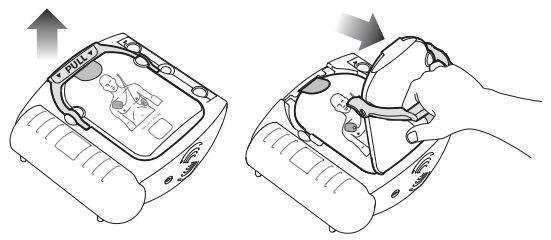
- Remove the hard cover from the pads cartridge and set it aside. Remain calm and follow the OnSite’s instructions.
The OnSite starts by directing you to remove all clothes from the patient’s chest. If necessary, rip or cut off the clothing to bare the person’s chest

* You can also turn on the OnSite by pressing the green On/Off button.
STEP 2: PLACE THE PADS
Pull the tab at the top of the pads cartridge to peel off the film seal.

- Inside are two adhesive pads on a plastic liner. Remove the pads from the cartridge.
- Peel one pad off the liner. Place the pad on the patient’s bare skin, exactly as shown in the picture on the pad.
- Press the pad down firmly. Then repeat this with the other pad. Be sure the pads have been removed from the liner before placing them.
Where to place pads on adults (anterior-anterior).

Where to place pads on infants or children under 55 pounds/25 kg or 8 years old (anterior-posterior).
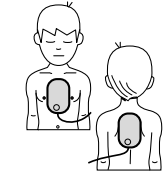
STEP 3: PRESS THE SHOCK BUTTON
As soon as the OnSite detects that the pads are attached to the patient, it begins analyzing the patient’s heart rhythm. It tells you that no one should be touching the patient, and the Caution light ![]() begins flashing as a reminder.
begins flashing as a reminder.
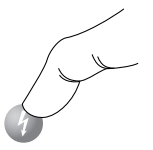
If a shock is needed:
The Caution light![]() goes from flashing to solid, the orange Shock button
goes from flashing to solid, the orange Shock button![]() starts flashing, and the OnSite tells you to press the flashing orange button. Before you press the button, make sure no one is touching the patient. When you press the Shock button, the OnSite tells you that the shock has been delivered. Then the OnSite tells you it is safe to touch the patient, instructs you to begin CPR, and invites you to press the flashing blue i-button
starts flashing, and the OnSite tells you to press the flashing orange button. Before you press the button, make sure no one is touching the patient. When you press the Shock button, the OnSite tells you that the shock has been delivered. Then the OnSite tells you it is safe to touch the patient, instructs you to begin CPR, and invites you to press the flashing blue i-button![]() for CPR guidance if desired.
for CPR guidance if desired.
If a shock is not needed:
The OnSite tells you it is safe to touch the patient and instructs you to perform CPR if needed. (If CPR is not needed – for example, if the patient is moving or regaining consciousness – follow your local protocol until emergency medical personnel arrive.) Then the OnSite invites you to press the flashing blue i-button![]() for CPR guidance, if desired.
for CPR guidance, if desired.
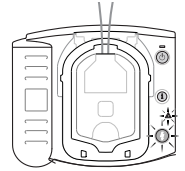
For CPR guidance:
Press the flashing blue i-button ![]() during the first 30 seconds of the patient care pause to activate CPR guidance.* (If the Infant/Child SMART Pads Cartridge is inserted, CPR guidance will provide guidance for infant/child CPR.) When the pause is over, the OnSite tells you to stop CPR, so it can analyze the patient’s heart rhythm. The motion caused by CPR can interfere with analysis, so be sure to stop all motion when instructed.
during the first 30 seconds of the patient care pause to activate CPR guidance.* (If the Infant/Child SMART Pads Cartridge is inserted, CPR guidance will provide guidance for infant/child CPR.) When the pause is over, the OnSite tells you to stop CPR, so it can analyze the patient’s heart rhythm. The motion caused by CPR can interfere with analysis, so be sure to stop all motion when instructed.

* The default configuration for the OnSite provides CPR guidance when you press the i-button in this situation; however, the default setting can be revised by your Medical Director using Philips software available separately. See Appendix E for more information.
TREATING INFANTS AND CHILDREN
WARNING: Most cardiac arrests in children are not caused by heart problems. When responding to cardiac arrest in an infant or child:
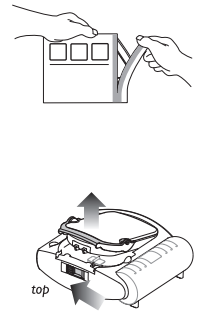
- Provide infant/child CPR while a bystander calls EMS and brings the OnSite.
- If no bystander is available, provide 1-2 minutes of CPR before calling EMS and retrieving the OnSite.
- If you witnessed the child's collapse, call EMS immediately and then get the OnSite.
Alternatively, follow your local protocol.
If the patient is under 55 pounds (25 kg) or 8 years old, and you have an infant/child SMART Pads Cartridge:
- Remove the Infant/Child SMART Pads Cartridge from its package.*
- Locate the latch at the top edge of the defibrillator, and slide it to the side. Any installed SMART pads cartridge will be released. Remove the old cartridge.
- Install the new infant/child SMART Pads Cartridge: slide the bottom end of the cartridge into the recess, then press in the cartridge until the latch clicks into place. Be sure the green handle is pressed down firmly. The OnSite will tell you that infant/child pads have been inserted, then it will turn off to be ready for use.
- Pull the green handle to start the rescue.
- Remove all clothing from the upper body, to bare both the chest and the back. Place one pad in the center of the chest between the nipples, and the other in the center of the back (anterior-posterior).
With the infant/child SMART Pads Cartridge inserted, the OnSite automatically reduces the defibrillation energy from the adult dose of 150 Joules to 50 Joules† and provides optional infant/child CPR guidance. Place the pads exactly as shown on the illustration on the pads.
* Philips recommends that the OnSite be stored with an adult pads cartridge installed, as pediatric cardiac arrest is not common.
† This lower energy level may not be effective for treating an adult.
If the patient is under 55 pounds (25 kg) or 8 years old, but you do NOT have an infant/child SMART Pads Cartridge:
- DO NOT DELAY TREATMENT.
- Remove all clothing from the torso, to bare both the chest and the back.
- Apply the OnSite using the adult SMART pads cartridge, but place one pad in the center of the chest between the nipples, and the other in the center of the back (anterior-posterior).
If the patient is over 55 pounds (25 kg) or 8 years old, or if you are not sure of the exact weight or age:
- DO NOT DELAY TREATMENT.
- Remove all clothing from the chest.
- Apply the OnSite using the adult SMART pads cartridge, and place the pads as illustrated on the pads (anterior-anterior). Make sure the pads do not overlap or touch each other.
WHEN EMERGENCY MEDICAL SERVICES ARRIVE
When Emergency Medical Services (EMS) personnel arrive to care for the patient, they may decide to apply another defibrillator to allow monitoring of the patient. The SMART Pads should be removed from the patient prior to using another defibrillator. EMS personnel may want a summary of the last-use data* stored in the OnSite. To hear the summary data, hold down the i-button until the OnSite beeps.
NOTE: After the EMS team removes the SMART Pads from the patient, remove the used SMART pads cartridge, and insert a new SMART pads cartridge before returning the OnSite to service, to be sure it is ready for use.
REMINDERS
- Remove any medicine patches and residual adhesive from the patient’s chest before applying the pads.
- Do not allow the pads to contact other electrodes or metal parts that are in contact with the patient.
- Avoid placing the pads directly over an implanted pacemaker or defibrillator. A noticeable lump with a surgical scar should indicate the position of an implanted device.
- If the pads do not stick well, check that the pads adhesive has not dried out. Each pad has a layer of adhesive gel. If the gel is not sticky to the touch, replace the pads with a new set.
- Keep the patient still and keep any movement around the patient to a minimum during rhythm analysis. Do not touch the patient or the pads while the Caution light is on solid or flashing. If the OnSite is unable to analyze due to electrical “noise” (artifact), it will tell you to stop all movement and remind you not to touch the patient. If the artifact continues for more than 30 seconds, the OnSite will pause briefly to allow you to deal with the source of the noise, then resume analysis.
- The OnSite will not deliver a shock unless you press the flashing orange Shock button. If you do not press the Shock button within 30 seconds after the OnSite tells you to, it will disarm itself, and (for the first CPR interval) give a reminder to make sure emergency medical services have been called, then begin a CPR interval. This is designed to minimize interruption of CPR and help ensure ongoing patient support.
- While waiting for you to press the Shock button, the OnSite will continue to analyze the heart rhythm. If the patient’s rhythm changes before you press the Shock button, and a shock is no longer needed, the defibrillator will disarm and tell you a shock is not advised.
- If for any reason you want to turn off the defibrillator during a use, you can press the On/Off button – holding it down for at least one second – to return the device to standby mode.
Setup Guide
To set up and operate the Philips HeartStart OnSite Defibrillator M5066A, follow these steps:
- Ensure the device is properly charged and that the SMART Pads cartridge is installed correctly.
- In the event of a cardiac emergency, turn on the device by pressing the green button.
- Follow the voice prompts and visual instructions to prepare the patient for defibrillation.
- Apply the SMART Pads to the patient's bare chest as directed by the device.
MAINTAINING THE HEARTSTART ONSITE
ROUTINE MAINTENANCE
The OnSite is very simple to maintain. The OnSite performs a self-test every day. In addition, a battery insertion self-test is run whenever a battery is installed in the device. The OnSite’s extensive automatic self-test features eliminate the need for any manual calibration. The OnSite has no user-serviceable parts.
WARNING: Electrical shock hazard. Do not open the OnSite, remove its covers, or attempt repair. There are no user-serviceable components in the OnSite. If repair is required, return the OnSite to Philips for service.
REMINDERS:
- Do not leave the OnSite without a SMART pads cartridge installed; the OnSite will start chirping and the i-button will start flashing. For directions on changing the pads cartridge, see Chapter 4, “After Using the HeartStart OnSite.”
- The OnSite runs daily self-tests. As long as the green Ready light is blinking, it is not necessary to test the OnSite by initiating a battery insertion self-test. This uses battery power and risks draining the battery prematurely.
PERIODIC CHECKS
Other than the checks recommended after each use of the OnSite, maintenance is limited to periodically checking the following:
- Check the green Ready light. If the green Ready light is not blinking, see Troubleshooting Tips, below.
- Replace any used, damaged or expired supplies and accessories.
- Check the outside of the OnSite. If you see cracks or other signs of damage, contact Philips for technical support.
Record each periodic check in your inspection log/maintenance booklet.
CLEANING THE ONSITE
The outside of the OnSite and its carry case can be cleaned with a soft cloth dampened in soapy water, chlorine bleach (2 tablespoons per quart or liter of water), or ammonia-based cleaners.
REMINDERS:
- Do not use isopropyl (rubbing) alcohol, strong solvents such as acetone or acetone-based cleaners, abrasive materials, or enzymatic cleaners to clean your OnSite.
- Do not immerse the OnSite in fluids or allow fluids to spill onto it.
- Do not sterilize the OnSite or its accessories.
TESTING
- As long as a battery is installed, the HeartStart OnSite Defibrillator automatically tests itself every day and alerts you if it finds a problem. The selftest includes pads readiness testing. In addition, it runs a pads self-test each time a SMART pads cartridge is inserted. It alerts you if it finds a problem.
- You can also test the OnSite at any time by removing the battery for five seconds then reinstalling it. This test takes about one minute. Because the battery insertion self-test is very detailed and uses battery power, running it more often than necessary will drain the battery prematurely. It is recommended that you run the battery insertion self-test only:
- when the OnSite is first put into service.
- after each time the OnSite is used to treat a patient.
- when the battery is replaced.
- when the OnSite may have been damaged.
- If you need to use the OnSite in an emergency while you are running a battery self-test, pull the SMART Pads Cartridge handle to stop the test and to turn on the OnSite for use.
TROUBLESHOOTING
The OnSite’s green Ready light is the signal that tells you if the OnSite is ready for use. The OnSite also uses chirps and the i-button flashes to alert you to a problem.
RECOMMENDED ACTION DURING AN EMERGENCY
If for any reason the OnSite does not turn on when you pull the SMART Pads Cartridge handle, press the On/Off button. If that does not turn on the OnSite, remove the battery and replace it with a new battery if available and press the On/Off button to turn on the OnSite. If no spare battery is available, remove the installed battery for five seconds, then reinsert it and run a battery insertion self-test.
If the problem continues, do not use the OnSite. Attend to the patient, providing CPR if needed, until Emergency Medical Services Personnel arrive.
TROUBLESHOOTING WHILE THE ONSITE IS IN USE
(green Ready light is solid)
OnSite tells you: | possible cause | recommended action |
... to replace the battery immediately | The battery is nearly depleted.The OnSite willturn off if a newbattery is not inserted. | Replace the battery with a new battery immediately. |
... there is no cartridge installed, and ... to insert a pads cartridge |
| Insert a newSMART pads cartridge. |
... to press the pads firmly to the skin ... to make surethe pads have been removed from the liner ... the pads shouldnot be touching the patient’s clothing. |
The SMART pads cartridge has been opened and the pads peeled off the liner, but the pads have not been successfully attached to the patient. There may be a problem with the SMART pads cartridge. |
|
... to insertnew pads cartridge | If the voiceinstruction continues after you do these things, insert another pads cartridge.
Replace the damagedSMART pads cartridge. Pull up the handleon the cartridge cover, and replace pads on patient with new pads to continue with the rescue. |
OnSite tells you: | possible cause recommended action | |
... to stop all motion |
|
|
... the shock was not delivered |
Shock has beenadvised but the shock button has not been pressed within 30 seconds. |
When next prompted, press the Shock button to deliver shock. |
... the shock button was not pressed | ||
TROUBLESHOOTING WHILE THE ONSITE IS NOT IN USE
(green Ready light is not on)
NOTE: In the event of a triple-chirp alert, even if the failure is cleared by a battery insertion test, please contact Philips for service. In the event of repeated instances of a self-test failure resulting in single-chirp alerts, even if such failures are cleared by a battery insertion test, please contact Philips for service.
behavior | possible cause | recommended action |
chirps or i-button flashes |
|
|
no chirping and/or i-button does not flash |
| Remove the battery for five seconds then reinstall it to startthe battery insertion self-test. If it fails, insert a new battery andrepeat the test.If it fails again,do not use the defibrillator. Contact Philipsfor service. |
Philips HeartStart OnSite Defibrillator M5066A Pros & Cons
Pros
- Ease of use: Simple one-button operation with clear voice instructions.
- Reliability: Long-lasting battery and durable design.
- Compactness: Lightweight and easy to transport.
- Advanced Technology: SMART Pads with built-in expiration dates ensure readiness.
Cons
- Cost: Can be expensive compared to other AED models.
- Maintenance: Requires periodic checks of battery and SMART Pads.
- Training: While easy to use, some users may still benefit from training sessions.
Customer Reviews
Customers have generally praised the Philips HeartStart OnSite Defibrillator M5066A for its ease of use and reliability. Many reviewers have noted that the clear instructions and visual cues make it easy for anyone to operate, even in high-stress situations. However, some users have mentioned that the cost can be prohibitive for smaller organizations or individuals.
Common complaints include the need for regular maintenance checks on the battery and SMART Pads, as well as the initial cost of purchasing the device.
Faqs
How do I know if my Philips HeartStart is ready for use?
Can anyone use the Defibrillator M5066A?
How long does the battery in the Philips HeartStart OnSite Defibrillator M5066A last?
What is included in the SMART Pads cartridge?
Is training required to use the Philips HeartStart OnSite?
How do I maintain my Defibrillator?
Can I use the Philips HeartStart on children?
What should I do if my HeartStart OnSite does not turn on?
Where can I purchase replacement parts for my HeartStart M5066A?
Leave a Comment
